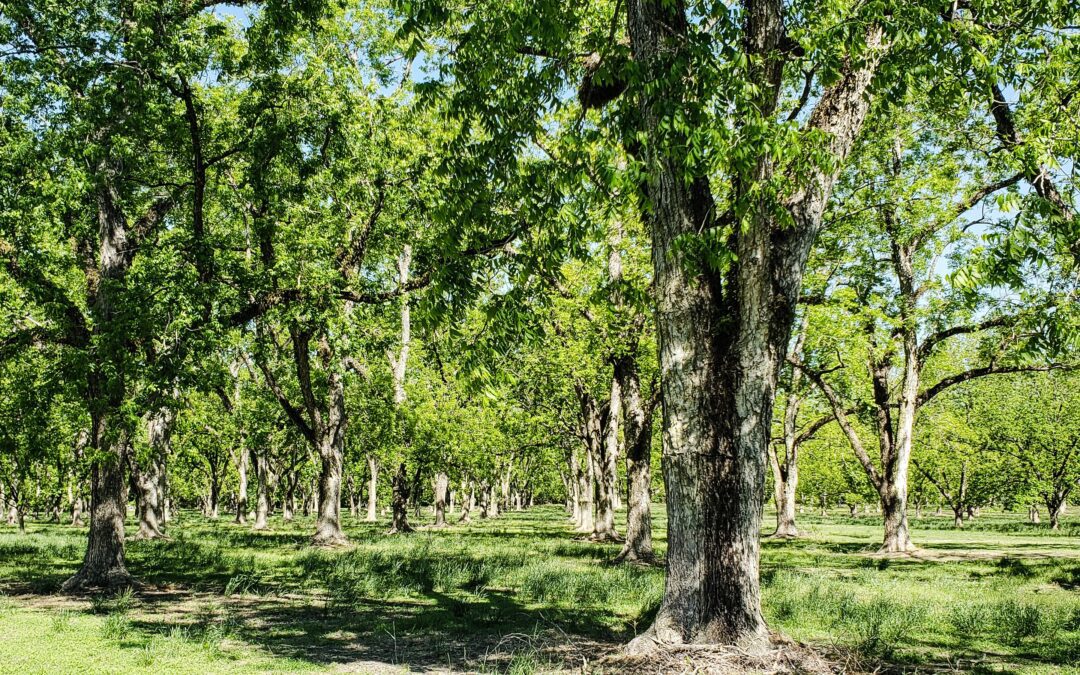If you’ve been watching or reading the news, you’ll have likely seen climate change dominate headlines. And with good reason: it can affect our food supply, and that includes trees bearing the iconic Georgia pecan.
Climate change occurs when greenhouse gasses trap heat in the Earth’s atmosphere, causing the temperature to climb. This can spark an early spring, causing plants to bloom earlier than they normally would. And while blossoms may be a welcome sight after a long winter, an early spring makes plants more susceptible to a cold snap. In turn, this increases a growers’ risk of not only crop loss, but of diminished revenue.
The good news: academics and scientists are putting their heads together to do something about the impact of climate change on pecan production. Let’s dive in and take a closer look!
Effects of Hot Weather on Pecan Trees
It’s no secret that when it’s hot and dry outside, trees require more water. Young (first-year) pecan trees, that don’t yet have enough of a root system, are particularly stressed when the temperature hits the high 90s.
Temperatures higher than 95 °F can kill feeder roots in shallow soil depth, putting more pressure on an already-stressed root system that’s trying to establish itself.
In mature trees, hot temperatures can cause leaves to drop. They may also come off when you spray the tree, particularly after a rainfall or irrigation in hot conditions. Pecan growers can help manage these conditions by keeping the soil around their trees consistently moist.
Georgia’s New Management Practices for Pecans
Experts in academia and non-profit organizations are joining forces to mitigate the impact of climate change on the land in Georgia, including pecan trees.
University of Georgia researchers, along with a global team of experts, and four faculty from the UGA College of Agricultural and Environmental Sciences (CAES),
are working on developing pecan trees better adapted to climate change, that yield desirable nut qualities, and are resistant to diseases, such as pecan scab.
Researchers are also working with farmers on management practices that can make orchards more resilient and fruitful. For example, strategic tree trimming can result in more compact trees that are healthier and use water more efficiently.
Farmers are also experimenting with planting one crop in the first half of the season, and planting another crop in the same spot for the season’s second half.
Selecting a Pecan Tree That Will Survive in Your Area
You can still enjoy growing pecan trees that will thrive as we battle climate change. Choosing a tree that’s right for your particular climate will make a huge difference to your success. In addition, there are many varieties of pecan trees to choose from!
But first, identify the climate zone you live in. Pecan trees can survive in zones 6-9, and sometimes zone 5, according to the U.S. Department of Agriculture’s Plant Hardiness Zone Map. Take a closer look at the map, and you’ll see, for example, California and the south are in zones 8 and 9. That means the Elliot pecan tree may do well in these areas compared to other pecan trees.
Move a little further north on the east coast to North Carolina, and you’ll be in a climate that would suit the Amling pecan tree. Areas such as Kansas and Missouri, meanwhile, can best host a Kanza, Hark, or Shepherd pecan tree.
Contact Georgia Pecan Nursery
Still not sure which pecan tree is right for you? Contact Georgia Pecan Nursery. We’re dedicated to providing pecan growers not just in Georgia, but across the U.S., with excellent quality, service and competitive pricing.
Discover the pecan trees we have available, and choose yours today.

